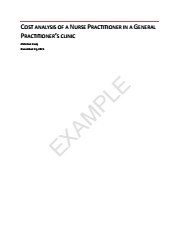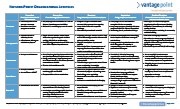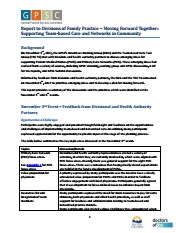5 public records – page 1 of 1. — Log in to view all records
Centralized Waiting Lists for Unattached Patients in Primary Care: Learning from an Intervention Implemented in Seven Canadian Provinces - Research Paper
https://www.jcc-resourcecatalogue.ca/en/permalink/divisionresource1159
- Published Date
- 2018-07-10
- Description
- "This article was referenced during the Centralized Waitlist- Patient Attachment Mechanisms webinar. It describes different models of centralized waitlists for unattached patients implemented in seven Canadian provinces and identifies common issues in the implementation of these centralized waitlists."
- Personal Author
- Mylaine Breton, Sabrina T. Wong, Mélanie Ann Smithman, Sara Kreindler, Jalila Jbilou, Emily Gard Marshall, Jason Sutherland, Astrid Brousselle, Jay Shaw, Valorie A. Crooks, Damien Contandriopoulos, Martin Sasseville and Michael Green
- Published Date
- 2018-07-10
- Topics
- Attachment
- Event
- Centralized Waitlist- Patient Attachment Mechanisms Webinar
- Resource Type
- Article
- Research Paper
- File Type
- Web page
- Originating web page
- https://www.researchgate.net/publication/326378660_Centralized_Waiting_Lists_for_Unattached_Patients_in_Primary_Care_Learning_from_an_Intervention_Implemented_in_Seven_Canadian_Provinces
- Citation
- Breton, M., Wong, S. T., Smithman, M. A., Kreindler, S., Jbilou, J., Marshall, E. G., ... Green, M. (2018). Centralized Waiting Lists for Unattached Patients in Primary Care: Learning from an Intervention Implemented in Seven Canadian Provinces. Healthcare Policy, 13(4). Retrieved from https://www.researchgate.net/publication/326378660_Centralized_Waiting_Lists_for_Unattached_Patients_in_Primary_Care_Learning_from_an_Intervention_Implemented_in_Seven_Canadian_Provinces
- Description
- This article was referenced during the Centralized Waitlist- Patient Attachment Mechanisms webinar. It describes different models of centralized waitlists for unattached patients implemented in seven Canadian provinces and identifies common issues in the implementation of these centralized waitlists.
Cost Analysis of a Nurse Practitioner in a GP Clinic
https://www.jcc-resourcecatalogue.ca/en/permalink/divisionresource509
- Health Authority
- Vancouver Coastal
- Division
- Powell River Division of Family Practice
- Program
- A GP for Me
- Published Date
- 2015-12-22
- Description
- "This document examines the financial impact of the work environment of a Nurse Practitioner (NP) on Vancouver Coastal Health’s (VCH) budget. It evaluates the cost effectiveness of having the NP work from a General Practitioners (GP) clinic compared to the community healthcare clinic in the hospital. NPs are working in many different primary care areas, as a specialist or as generalist in a primary care setting. Compared to physicians, patient satisfaction and quality of care have been equal or higher than care provided by physicians. NPs are effective in the reduction of patient unattachment and reduction of emergency department (ED) visits. Although NPs take often more consultation time and sometimes conduct more preventative actions, their work can be comparable or even more effective compared to other providers. This study hypothesized that the NP’s direct patient time and accessibility increases in the GP clinic, leading to a reduction of ED cost. ED and hospitalization cost of NP patients one year prior to attachment is compared with one year after attachment. Cost effectiveness is calculated by deducting incremental work environment cost by avoided ED and hospitalization cost."
- Health Authority
- Vancouver Coastal
- Division
- Powell River Division of Family Practice
- Program
- A GP for Me
- Corporate Author
- Powell River Division of Family Practice
- Personal Author
- Christien Kaaij
- Published Date
- 2015-12-22
- Resource Type
- Report
- File Type
- Description
- This document examines the financial impact of the work environment of a Nurse Practitioner (NP) on Vancouver Coastal Health’s (VCH) budget. It evaluates the cost effectiveness of having the NP work from a General Practitioners (GP) clinic compared to the community healthcare clinic in the hospital. NPs are working in many different primary care areas, as a specialist or as generalist in a primary care setting. Compared to physicians, patient satisfaction and quality of care have been equal or higher than care provided by physicians. NPs are effective in the reduction of patient unattachment and reduction of emergency department (ED) visits. Although NPs take often more consultation time and sometimes conduct more preventative actions, their work can be comparable or even more effective compared to other providers. This study hypothesized that the NP’s direct patient time and accessibility increases in the GP clinic, leading to a reduction of ED cost. ED and hospitalization cost of NP patients one year prior to attachment is compared with one year after attachment. Cost effectiveness is calculated by deducting incremental work environment cost by avoided ED and hospitalization cost.
Not-For-Profit Lifecycles
https://www.jcc-resourcecatalogue.ca/en/permalink/divisionresource401
- Link to File
- /media/divresources/NotforProfitLifecycleTable.pdf
- Description
- "This table lays out the key stages in a not-for-profit's organizational lifecycle and how that translates in programs, management, governance, operations, and finances."
- Corporate Author
- Vantage Point
- Event
- Co-ED Learning Labs
- Workshop
- Pre-Work Day 1
- Resource Type
- Report
- File Type
- Link to File
- /media/divresources/NotforProfitLifecycleTable.pdf
- Description
- This table lays out the key stages in a not-for-profit's organizational lifecycle and how that translates in programs, management, governance, operations, and finances.
Report – Moving Forward Together: Supporting Team-based Care and Networks in Community
https://www.jcc-resourcecatalogue.ca/en/permalink/divisionresource1042
- Program
- Divisions of Family Practice
- Published Date
- 11-03-2017
- Description
- "Report from the Moving Forward Together: Supporting Team-based Care and Networks Community event on Nov 3 & 6, 2017. The GPSC’s Incentives Working Group (IWG) and the Team-based Care Task Group (TBC TG) met with Divisions and health authority partners to discuss emerging ideas for supporting Patient Medical Homes (PMH) and Primary Care Networks (PCN)."
- Program
- Divisions of Family Practice
- Corporate Author
- General Practice Services Committee
- Published Date
- 11-03-2017
- Event
- Moving Forward Together: Supporting Team-based Care and Networks in Community
- Resource Type
- Report
- File Type
- Description
- Report from the Moving Forward Together: Supporting Team-based Care and Networks Community event on Nov 3 & 6, 2017. The GPSC’s Incentives Working Group (IWG) and the Team-based Care Task Group (TBC TG) met with Divisions and health authority partners to discuss emerging ideas for supporting Patient Medical Homes (PMH) and Primary Care Networks (PCN).
The Value Proposition for Primary Care
https://www.jcc-resourcecatalogue.ca/en/permalink/divisionresource939
- Published Date
- 2015
- Link to File
- http://www.gpscbc.ca/sites/default/files/uploads/GPSC%20Visioning%20The%20Value%20Proposition.pdf
- Description
- "This one-pager makes the case that strong primary care system, centred on continuous doctor-patient relationships, leads to the best health outcomes for patients, and can also lead to cost benefits for the health care system."
- Corporate Author
- General Practice Services Committee
- Published Date
- 2015
- Topics
- Attachment
- Resource Type
- Report
- File Type
- Link to File
- http://www.gpscbc.ca/sites/default/files/uploads/GPSC%20Visioning%20The%20Value%20Proposition.pdf
- Originating web page
- http://www.gpscbc.ca/what-we-do/collective-voice/visioning
- Description
- This one-pager makes the case that strong primary care system, centred on continuous doctor-patient relationships, leads to the best health outcomes for patients, and can also lead to cost benefits for the health care system.



